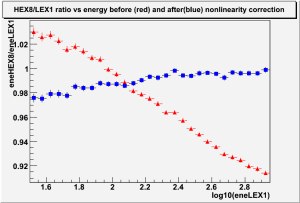From the study of Data/MC signal ratios in beam test runs Philippe concluded that all calorimeter crystals have uncorrected nonlinearity in the energy range between 10 MeV and 200 MeV, so that the ratio of the reconstructed energy to the true energy increases from 1.00 to 1.12 when energy increases from 10 MeV to 200 MeV. Above this energy the Data/MC ratio shows very slow decrease. Philippe suggested to correct this residual nonlinearity in CU crystals by simple function and eventually apply the same correction to LAT reconstruction as well.
To verify if this correction should be applied to LAT I tried to measure the residual nonlinearity in LEX1 by looking at the HEX8/LEX1 ratio and considering that HEX8 range is linear because from charge injection measurement the non-linearity in HEX8 is by order of magnitude smaller than in LEX1.
The following plot shows the correlation between HEX8 and LEX1 energies between 2 and 1000 MeV. Energy depositions from all 3072 crystal end are plotted on the same histogram. Red points represent the raw adc values multiplyed by linear calibration coefficients (used normally by onboard software) i.e without any correction of nonlinearity. Blue points represents reconstructed energies at each crystal end, i.e. using nonlinearuty correction by the function measured by charge injection calibration.
One can see that non-linearity correction is up to 10 % and definitely inproves the situation. Without correction LEX1 energy would be ~10% bigger than HEX8 energy at the end of the range.
Unfortunately, due to significant noise in HEX8 range (~6 MeV sigma) we cannot use this method to study nonlinearity below 3*sig ~ 20 MeV, as profile will be biased by LAC threshold. But we can make profile plot of HEX8/LEX1 ratio for energies between 30 MeV and 1000 MeV in log scale. Please note that this plot shows inversed quantity with respect to Philippe's plot of residual nonlinearity, becasue I use HEX8/LEX1 ratio, so if LEX1 is overestimated, then the ratio on my plot would be less than 1.
Red points shows the HEX8/LEX1 ratio without nonlinearity correction, blue points - after standard nonlinearity correction with charge injection spline used actualy in reconstruction.
One can see that after nonlinearity correction the nonlinearity (difference in ratio between 30 MeV and 1000 MeV) decreases from 12% to 2% and changes sign, so we've overcorrected the real nonlinearity.
The residual nonlinearity, representad by blue points have the shape similar to Philippe's curve for CU (change of slope at ~200 MeV), but smaller amplitude and opposite direction
So, I confirm that the effect similar to one seen by Philippe in CU, exist in LAT, but it has different amplitude and direction, so it should be measured and corrected independently from beam test data.
But for calibration unit the correction proposed by Philippe could be applied and should be implemented in reconstruction.

